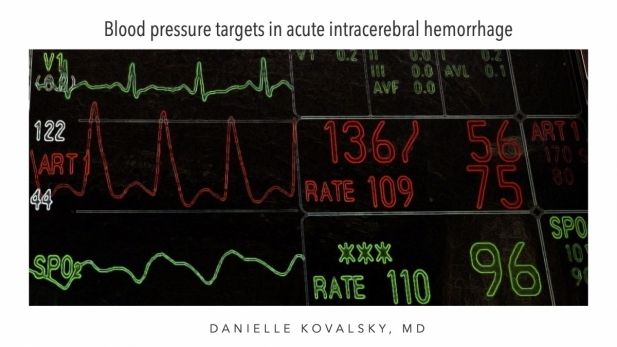Blood pressure management in acute intracerebral hemorrhage

Blood Pressure Management in Spontaneous Intracerebral Hemorrhage
What is a Spontaneous Intracerebral hemorrhage (ICH)?
Parenchymal hemorrhage resulting from rupture of blood vessels in the brain
Accounts for 8-11% of all strokes
Risk factors:
Hypertension- most common cause overall
Arteriovenous malformations - most common cause in children
Amyloid angiopathy - most common cause in elderly
Arterial aneurysm
Use of anticoagulant therapy
Drugs such as cocaine (sympathomimetics)
Intracranial tumors
Why is blood pressure control important in these patients?
Avoiding hypertension could possibly limit expansion of hematoma. However, there is mixed evidence regarding whether or not there are clinically significant differences in hematoma expansion with aggressive blood pressure control
Patients may present with hypertension greater than their baseline due to disruption of central pathways regulating blood pressure.
What are the current blood pressure goal recommendations?
SBP > 220 mmHg
Consider aggressive treatment with IV antihypertensive infusion
Goal BP 140-160 mmHg
SBP 150-220 mm Hg
Consider lowering SBP to 140 mmHg
A 2016 study, ATACH-2 (Antihypertensive Treatment of Acute Cerebral Hemorrhage-II) showed that rapid lowering of systolic blood pressure to a target of 110-139 mmHg did not improve death or disability (modified Rankin 4-6) compared to a goal systolic blood pressure of 140-179 mm Hg. The rate of renal adverse events was significantly higher in the intensive-treatment group targeting 110-139 mm Hg.
What medications should we be using?
Nicardipine
Onset: within minutes (IV)
Dosing: continuous IV infusion starting at 5 mg/hour, increase by 2.5 mg/hour every 5-15 minutes in order to achieve BP goals. Maximum dose is 15 mg/hour.
Avoid in patients with advanced aortic stenosis
Labetalol
Onset: within 5 minutes (IV)
Dosing: 10-20 mg IV push over 2 minutes then 20-80 mg every 10-15 minutes until you achieve BP goal, up to 300 mg total.
Avoid in patients with bradycardia, heart block greater than 1st degree, asthma with active bronchospasm, heart failure
Esmolol
Onset: within 2-10 minutes (IV)
Dosing: loading dose 500-1,000 mcg/kg over 1 minute followed by 50 mcg/kg/minute infusion over 4 minutes. If adequate BP response is not achieved, repeat loading dose and increase infusion rate by increments of 50 mcg/kg/min. Can repeat this for four boluses to a total infusion rate of 300 mcg/kg/min.
Avoid in patients with bradycardia, heart block, cardiogenic shock, heart failure, or asthma with active bronchospasm
Other drugs recommended: Clevidipine, enalaprilat, fenoldopam, phentolamine
References
Baumann, B. (2020). Section 7: Cardiovascular Disease. In Tintinalli's Emergency Medicine: A Comprehensive Study Guide (9th ed., pp. 404-406). New York, NY: McGraw-Hill Education.
Qureshi AI, Mendelow AD, Hanley DF. Intracerebral haemorrhage. Lancet. 2009;373(9675):1632-1644.
Qureshi AI, Palesch YY, Barsan WG, et al. Intensive Blood-Pressure Lowering in Patients with Acute Cerebral Hemorrhage. N Engl J Med. 2016;375(11):1033-1043.
